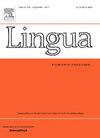Projecting incongruity in turn and action: the TCU-medial particle ha in Chinese conversation
IF 1.3
3区 文学
0 LANGUAGE & LINGUISTICS
引用次数: 0
Abstract
This study investigates the interactional function of the particle ha in TCU-medial position in Chinese talk-in-interaction. While ha is generally recognized as a modal particle that solicits affirmation or confirmation in sentence-final position, and functions as a theme indicator, politeness marker, or filler in sentence-medial position, our analysis of naturally occurring conversational data reveals a distinct interactional use. Specifically, speakers deploy ha in mid-TCU to project relations of inconsistency, adversativeness, contrast, or unexpectedness between components within the same TCU. When occurring in responsive turns, ha also serves to foreshadow disalignment and/or disaffiliation with the prior speaker’s action. This projectability contributes to the organization of turn-taking by helping recipients anticipate the forthcoming incongruity and orient toward a possible transition-relevance place. In doing so, ha affords recipients additional processing time to prepare a response that is interactionally fitted to the projected stance or action. This study contributes to our understanding of grammar-in-interaction and projection in turn construction and action. Data are presented in Chinese with English translation.
轮流与行动的不协调投射:汉语会话中的tcu -中间粒子ha
本研究探讨了汉语谈话互动中tcu -中间位粒子ha的互动功能。虽然ha通常被认为是在句末位置请求肯定或确认的情态助词,并且在句中位置用作主题指示、礼貌标记或填充词,但我们对自然发生的会话数据的分析揭示了其独特的交互用法。具体来说,讲话者在TCU的中间部署它,以显示同一TCU内组件之间的不一致、对应性、对比或意外关系。当发生在响应性回合时,这也预示着与前一个说话者的动作不一致和/或不一致。这种可投射性通过帮助接受者预测即将到来的不协调并朝向可能的过渡相关位置,有助于组织轮流。在这样做的过程中,它为接受者提供了额外的处理时间来准备一个与预期的立场或动作相互适应的反应。本研究有助于我们对互动语法和投射的理解,进而对结构和动作的理解。资料以中文呈现,并附有英文翻译。
本文章由计算机程序翻译,如有差异,请以英文原文为准。
求助全文
约1分钟内获得全文
求助全文
来源期刊

Lingua
Multiple-
CiteScore
2.50
自引率
9.10%
发文量
93
审稿时长
24 weeks
期刊介绍:
Lingua publishes papers of any length, if justified, as well as review articles surveying developments in the various fields of linguistics, and occasional discussions. A considerable number of pages in each issue are devoted to critical book reviews. Lingua also publishes Lingua Franca articles consisting of provocative exchanges expressing strong opinions on central topics in linguistics; The Decade In articles which are educational articles offering the nonspecialist linguist an overview of a given area of study; and Taking up the Gauntlet special issues composed of a set number of papers examining one set of data and exploring whose theory offers the most insight with a minimal set of assumptions and a maximum of arguments.
 求助内容:
求助内容: 应助结果提醒方式:
应助结果提醒方式:


